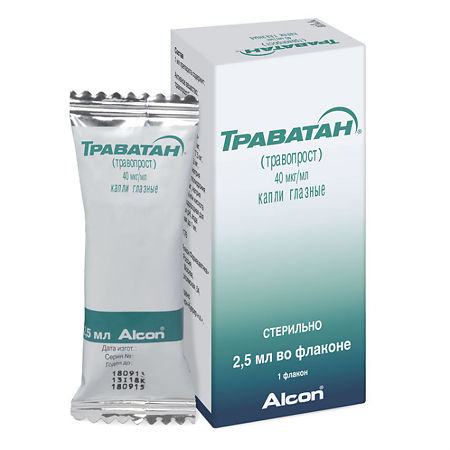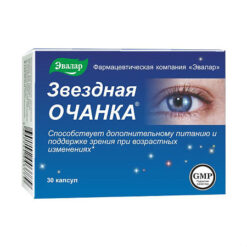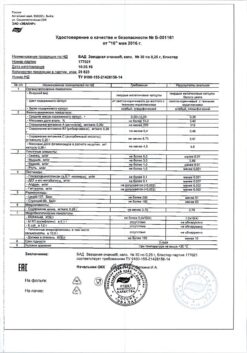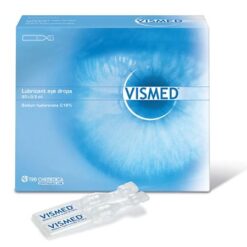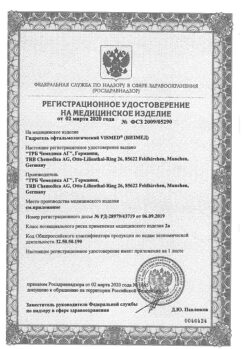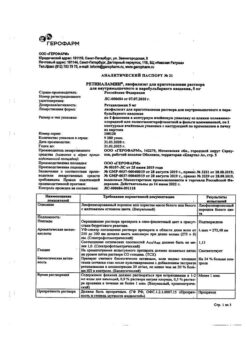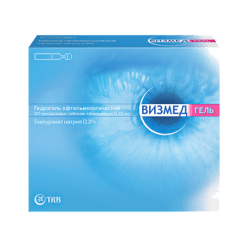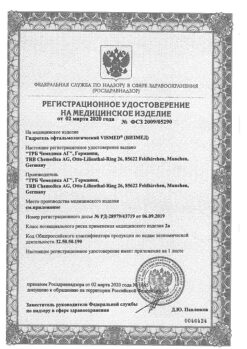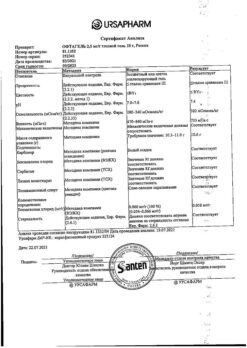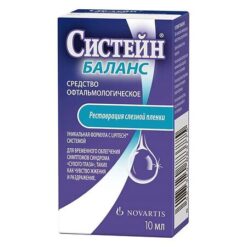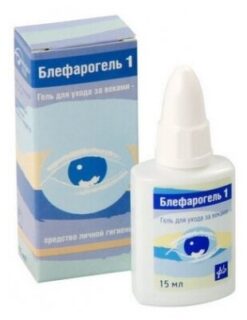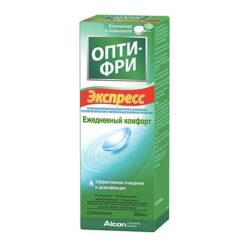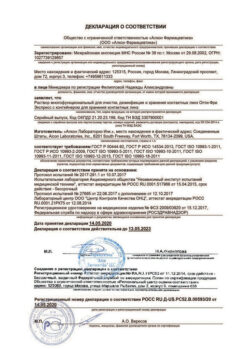No products in the cart.
Travatan, eye drops 40 µg/ml 2.5ml
€24.99 €20.82
Description
Travatan has an anti-glaucomatous effect. The main active substance of the drug, travoprost, is a synthetic analog of prostaglandin F2-alpha, which selectively activates FP-receptors of the ciliary body and causes increased outflow of intraocular fluid filling the space between the lens and the cornea, which is accompanied by a decrease in intraocular pressure. Travathan predominantly enhances the uveoscleral aqueous outflow pathway with no detectable effect on intraocular fluid production.
The anti-occlusive effect of travoprost appears approximately 120 minutes after instillation of the drug with maximum hypotensive effect within 12 hours.
Pharmacokinetics
Absorption and metabolism
Travoprost is absorbed through the cornea of the eye, where hydrolysis of travoprost to its biologically active form, travoprost acid, occurs.
The Cmax of hervoprost in plasma is reached within 30 minutes after topical application and is 25 pg/ml or less.
Elimination
Travoprost is rapidly eliminated from plasma, within one hour the concentration drops below the detection threshold (< 10 pg/ml).
Travoprost is excreted as inactive metabolites mainly in the bile (61%), the rest is excreted by the kidneys.
Indications
Indications
Travatan is used in the complex therapy of open-angle glaucoma, as well as to reduce intraocular pressure in patients with increased ophthalmotonus.
Pharmacological effect
Pharmacological effect
Travatan has an antiglaucomatous effect. The main active ingredient of the drug, travoprost, is a synthetic analogue of prostaglandin F2-alpha, which selectively activates FP receptors of the ciliary body and causes an increased outflow of intraocular fluid filling the space between the lens and the cornea, which is accompanied by a decrease in intraocular pressure. Travatan enhances predominantly the uveoscleral pathway of aqueous humor outflow, without having a noticeable effect on the production of intraocular fluid.
The antiglaucoma effect of travoprost appears approximately 120 minutes from the moment of instillation of the drug, the maximum hypotensive effect develops within 12 hours.
Pharmacokinetics
Absorption and Metabolism
Travoprost is absorbed through the cornea of the eye, where travoprost is hydrolyzed to its biologically active form, travoprost acid.
Cmax of travoprost in blood plasma is achieved within 30 minutes after topical application and is 25 pg/ml or less.
Removal
Travoprost is rapidly cleared from plasma, within an hour the concentration decreases below the detection threshold (< 10 pg/ml).
Travoprost is excreted in the form of inactive metabolites mainly in bile (61%), the rest is excreted by the kidneys.
Special instructions
Special instructions
Treatment of only one eye can lead to permanent heterochromia.
In the presence of nevi or lentigines on the iris, no changes were noted under the influence of the drug.
The drug may cause darkening, thickening and lengthening of eyelashes and/or an increase in their number; rarely – darkening of the skin of the eyelids.
If Travatan is used with other antiglaucoma drugs for topical use, the interval between their use should be at least 5 minutes.
It is recommended to remove contact lenses before using the drug to avoid compromising the transparency of contact lenses. Place them back no earlier than 20 minutes after the procedure.
The bottle must be closed after each use.
The drug may cause a gradual change in eye color by increasing the amount of brown pigment in the iris. This effect is detected predominantly in patients with mixed iris coloration, for example, blue-brown, gray-brown, green-brown or yellow-brown, which is explained by an increase in the melanin content in the stromal melanocytes of the iris. Typically, brown pigmentation extends concentrically around the pupil to the periphery of the iris, and the entire iris or parts of it may become a more intense brown color.
In patients with uniformly colored eyes of blue, grey, green or brown, changes in eye color were very rare after two years of use of the drug. The color change is not accompanied by any clinical symptoms or pathological changes.
After discontinuation of the drug, no further increase in the amount of brown pigment was observed, however, the color change that has already developed may be irreversible.
Before starting treatment, patients should be informed about the possibility of changes in eye color.
Active ingredient
Active ingredient
Travoprost
Composition
Composition
Active ingredient:
travoprost 0.04 mg;
Excipients:
macrogol glyceryl hydroxystearate (synonym – polyoxyethylene hydrogenated castor oil 40 – HCO-40);
benzalkonium chloride solution (equivalent to benzalkonium chloride);
disodium edetate;
boric acid;
trometamol;
mannitol;
sodium hydroxide and/or concentrated hydrochloric acid – to adjust the pH;
the water is purified.
Pregnancy
Pregnancy
Travatan is contraindicated in women during pregnancy.
There is no sufficient experience with the use of the drug during breastfeeding. It is possible to use Travatan for the treatment of nursing mothers as prescribed by the attending physician, if the expected therapeutic effect exceeds the risk of developing possible side effects for the child.
Use in children
The drug is contraindicated in children and adolescents under 18 years of age.
Contraindications
Contraindications
Travatan eye drops are not used in case of individual hypersensitivity to the components of the drug, during pregnancy and during breastfeeding, as well as for the treatment of patients under 18 years of age.
With caution: risk factors for the development of macular edema (aphakia, pseudophakia, damage to the posterior capsule of the lens), acute iritis, uveitis.
Side Effects
Side Effects
In 35% of cases, transient mild hyperemia of the conjunctiva is observed, which resolves without additional therapy over time.
In 5–10% of cases there is a decrease in visual acuity, a feeling of discomfort and a “foreign body sensation”, pain, itching, burning in the eyes.
In 1–4% of cases – visual disturbances, blepharitis, “fog” before the eyes, cataracts, conjunctivitis, dry conjunctiva, changes in the color of the iris, keratitis, crust formation on the edges of the eyelids, photophobia, subconjunctival hemorrhages and increased lacrimation.
Systemic side effects observed in 1–5% of cases: general anxiety, headache, depression, increased or decreased blood pressure, bradycardia, angina pectoris, chest pain, arthritis, back pain, influenza-like syndrome, sinusitis, bronchitis, hypercholesterolemia, dyspepsia, urinary incontinence and urinary tract infections.
Interaction
Interaction
Travatan can be used in combination with other local ophthalmic drugs to reduce intraocular pressure.
In this case, the interval between their use should be at least 5 minutes.
Overdose
Overdose
Symptoms: irritation of the mucous membrane of the eye, hyperemia of the conjunctiva or episclera.
Treatment: symptomatic.
Storage conditions
Storage conditions
At 2–25 °C
Shelf life
Shelf life
3 years
Manufacturer
Manufacturer
S.A. Alkon-Couvreur n.v., Belgium
Additional information
| Shelf life | 3 years |
|---|---|
| Conditions of storage | At 2-25 °C |
| Manufacturer | s.a. Alcon-Couvreur n.a., Belgium |
| Medication form | eye drops |
| Brand | s.a. Alcon-Couvreur n.a. |
Related products
Buy Travatan, eye drops 40 µg/ml 2.5ml with delivery to USA, UK, Europe and over 120 other countries.

